Piano Lesson 2 :
Showing the Page Horizontally [Lesson 2]
From now on we will show the lines horizontally, the notes are played across the page from left to right. If you initially have any difficulties, turn the page sideways. Try to avoid following the lines back to the keyboard at the side of the page. Instead, visualise the groups of two and three lines as the black notes.
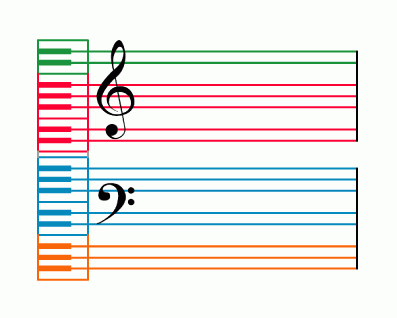

Two Octave Music
Put two octaves together and the lines look like this. The gap in the middle of the lines represents the middle of the piano.
[PIC]
Three Octave Music
Once you are used to reading the left and right hand octaves we can add extra lines on the top and bottom to show three octaves on a standard printed page.
[PIC]
Extra high or Low Notes
Notes played outside these three octaves will be shown with additional grey lines ("ledger lines").
[PIC]
Musical Bars
Music is written in small groups of notes called bars. The groups are separated by vertical barlines. The first note in each bar is often the loudest and the bars help form the beat (rhythm) of the music. Each bar is the same length in time.
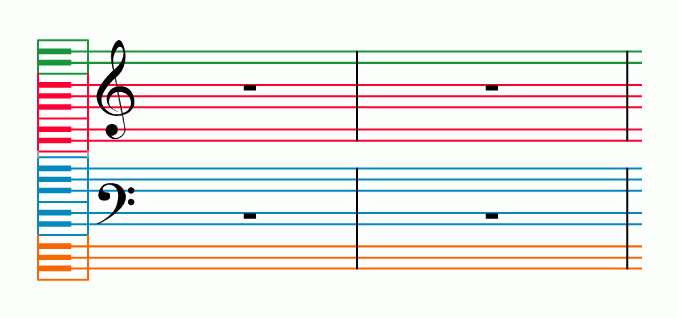
Note Duration
Notice that the notes now have lines, or stems, attached. Usually, notes played by the right hand have stems pointing up, and notes played by left hand have stems going down. Some of the notes are filled in and some are not. The notes that are filled in are short notes. The notes that are not filled in are long notes and are held for twice as long as the short ones.
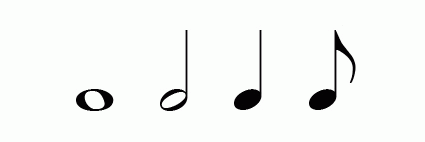
Count aloud "1, 2", as you play each note in the bar. In bar 9, there are four notes. Again, count aloud "1" and "2" but at the same speed - i.e. only count on the first and third notes. A good counting trick used by musicians is to add a sound for the notes you are not counting: for example, in bar 9, you could count "1-ta, 2-ta" for the four notes. You are counting the beat. Notice how, in bar 9, the stems of these notes are joined together, and are thus played twice as fast as a normal filled in note.
- A circle without a stem is played for all 4 beats and is called a semibreve.
- A circle (a note that is not filled) with a stem is played for 2 beats and is called a minim.
- A black note (filled in) is played for 1 beat and is called a crotchet.
- A black note joined to another black note is played for half a count and is called a quaver.
Time Signatures
There are often two numbers at the beginning of a piece. The top number gives the number of beats in each bar. In this piece there are 4 beats to a bar. The bottom number gives the time length of each beat. Here number 4 means that each beat is a crotchet.

In this piece the top number is 2, so there are 2 beats in each bar. The bottom number is 4, which means these two beats are crotchets.

In this piece the upper number is 3, so there are 3 crotchet beats in each bar.

Dotted Notes
When there is a dot after a note its length is increased by half again. A dotted crotchet will be one and a half beats long.


Scales
The sequence of notes below is called a scale. Tunes are written in different "scales" of 8 notes, according to the mood and sound of music desired. That tune will then mainly use only these 8 notes in each octave. Scales are practised so that these 8 notes are familiar to your fingers when played in a piece. There are more notes in the scale than there are fingers on one hand, so it is useful to use more than one finger. Play the first three notes with fingers 1 (the thumb), 2, 3, respectively. When you reach the fourth note on the way up turn your thumb (finger 1) under your other fingers to play it. Then you can use fingers 2 and 3 for the next notes, and so on. On the way down you need to reverse the process and turn you finger 3 (the middle finger) over your thumb after you have played the note.

This scale is called a C Major scale. Here are several other major scales, which use the same fingering. At the back of this book you will find all the major scales with annotated fingering.
Playing Hands Together
Until now each hand has played separately. In this piece play the right and left hands at the same time. Practise each hand separately before trying them together.
Tied Notes
When a note is joined (tied) by a curved line (a tie) to the next note (of the same pitch) it is held down for the combined time of both notes and not played twice. The two notes may be in the same bar or in different bars.

Rests
A period of silence is indicated by a sign called a rest. There are different rest signs to correspond with different note lengths.
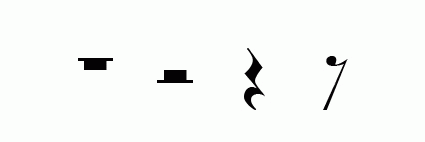
Staccato and Legato Notes
A note with a dot above or below is played as a very short stab called staccato. The opposite of staccato is legato, which means you should play as smoothly and gracefully as possible.

Slurs and Phrases
When a group of notes has a curved line above or below it, each of these notes is held down until the next is played. These notes are played smoothly (legato, see above). The curved line is called a slur. The notes within it form a musical phrase. When you have two phrases next to each other, there should be a slight pause between them - done by slightly shortening the last note of the first phrase.

Semiquavers
Another common note time value is called a semiquaver. This looks like a quaver but has 2 lines on the stem and is again played twice as fast. 2 semiquavers last as long as 1 quaver. A dotted quaver is equal in length to 3 semiquavers, or 1 and a half quavers. Similarly, a semiquaver rest looks like a quaver rest but has 2 lines on its stem.

Major Scale
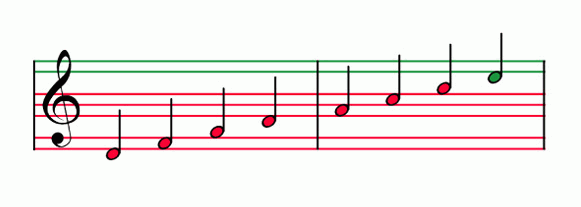
Minor Scales
For each major scale there are corresponding minor scales. To make a minor scale the third note of the major scale is flattened = moved down one key, semi-tone, = moved to the adjacent black or white note on its left, Minor scales are often used for sad or moody tunes.
Chords
A chord is a group of 2 or more notes played together. These notes are at fixed separations (intervals) and their sounds will become familiar with practise. For each major scale there are major chords and for each minor scale there are minor chords. In most beginners` music, a chord is made up of 3 notes. Listen to the difference between the major and minor chord.
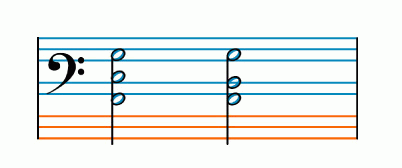
The major chord has a `happy` sound while the minor chord has a `sad` sound. At the back of this book you will find examples of several major and minor chords. With these two types of chords it is possible to create an accompaniment, or harmony, to most tunes.
Complex time signatures
Earlier on, simple time signatures were mentioned. Another common time signature is 6/8, and is known as a complex time signature. Here, the upper number is 6, which means there is space for 6 notes in each bar. The lower number is 8, which means these notes are measured in quavers. So, in one bar of 6/8 you can fit 6 quavers. Simple time signatures are known as duplet time, because their beats divide into two. The most common complex time signatures (such as 6/8) use triplet time, meaning that the beat divides into three. For example, in 6/8 you have two groups of three quavers.
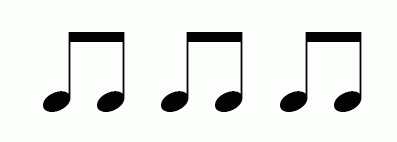

Don`t worry if you`re confused - it is much easier to imagine the difference using an example. Recall, in the first lesson, we counted "1-ta, 2-ta" for a simple time signature of 2/4, where the bar was composed of quavers. In 6/8, you would count "1-ta-ta, 2-ta-ta" - just like an Irish Jig.


